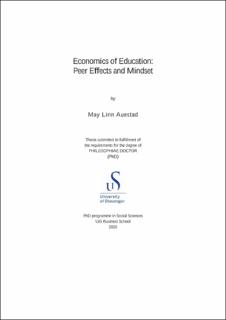Economics of Education: Peer Effects and Mindset
Doctoral thesis
Permanent lenke
https://hdl.handle.net/11250/2673552Utgivelsesdato
2020-09Metadata
Vis full innførselSamlinger
Originalversjon
Economics of Education: Peer Effects and Mindset by May Linn Auestad. Stavanger: University of Stavanger 2020 (PhD thesis UiS, no. 539)Sammendrag
In a world where technology is becoming ever more important, children’s best chance to thrive in school, and later, succeed in the labor market is by striving towards exploiting their full potential and acquire an applicable education. Evidence suggests that the future labor market will require more formal education, especially within science, technology, engineering and math, commonly referred to as the STEM fields (Freeman & Aspray, 1999; Petersen & Hyde, 2014). Additionally, mastering only the technical aspects of a job will no longer be sufficient; social and emotional skills will be essential as computers and robots take over routine tasks (Deming, 2017; Edin et al., 2017; Heckman et al., 2006; Heckman & Kautz, 2012; Kautz et al., 2014; OECD Publishing, 2013).
Furthermore, given that the advances in technology mean that the labor market is constantly changing, those who are able to practice lifelong learning are bound to experience some benefits. An obvious advantage in this regard is believing that intelligence and talents can be developed and changed through effort, perseverance, hard work and by using different strategies, commonly referred to as holding a growth mindset (Dweck, 2006; Mueller & Dweck, 1998; Yeager & Dweck, 2012).
Outside of the home, schools, and especially classrooms, are perhaps the most important arena for children developing the competencies they will need to flourish (Hamre & Pianta, 2005; Howes, Hamilton, & Matheson, 1994). The learning environment across or perhaps even within schools, however, can be rather different as there are several components that affect what happens in the classroom (Chetty et al., 2011; Rockoff, 2004). In this thesis I examine important aspects of two such components; other students, commonly referred to as peers, and teachers. My goal is to contribute to understanding how we can help more children thrive in school, and consequently achieve more of their potential, using existing resources.
Består av
Paper 1: Auestad, M. L. (2018). The effect of low-achieving peers. Labour Economics, 55, 178-214Paper 2: Girls in STEM: the role of teacher mindset (with Eric Bettinger, Mari Rege and Ingeborg F. Solli).
Paper 3: Involving the teachers: effects of a growth mindset intervention with teacher involvement (with Mari Rege and David S. Yeager).

